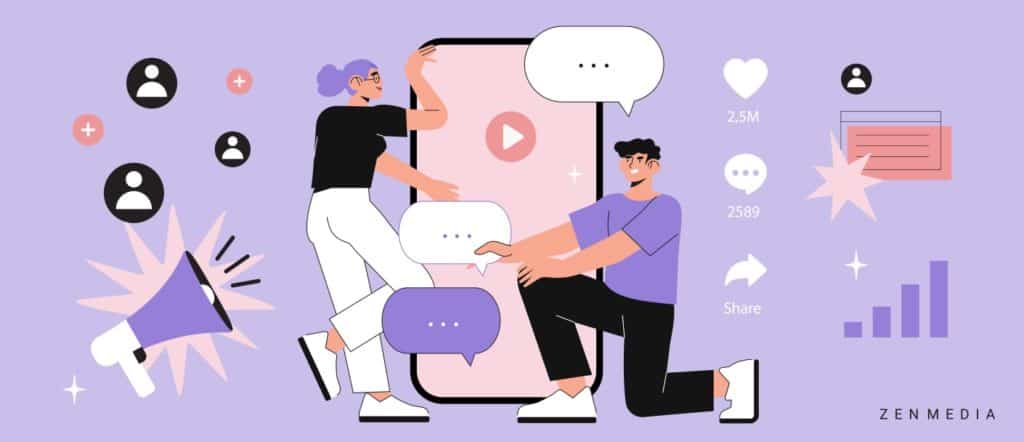Still, planning your 2024 digital marketing campaigns? Here are all of the things you should consider and try in Q1 and beyond.
What are the recent trends in B2B marketing?
Of course, the core B2B marketing principles of recent years still apply—a personalized, trustworthy content strategy is king—but now there are even more ways to accomplish that goal in the eyes of your audience.
We’ve covered many B2B marketing trends—from TikTok strategies to B2B marketing events—but we’ve compiled the trends that will stick in 2024 to help you kick off Q1 on the right foot.
6 B2B Marketing Trends to Know for 2024
1. TikTok’s Role in B2B Marketing Strategy
Building your brand presence or going “viral” on TikTok can be a strong leverage point to use for PR initiatives. TikTok is a “sexy” platform, and many publishing and news outlets will be more inclined to share your brand if it’s making headlines over on TikTok. Although the social content itself may not lead to sales, integrating those social ‘wins’ with your PR and paid ads teams can enhance your overall brand visibility and reputation.
Furthermore, TikTok content can be a valuable source of organic content for B2B brands. By garnering a following on TikTok, brands can create a reservoir of engaging content that can be repurposed across other owned channels, amplifying their reach and engagement beyond the platform itself.
TikTok provides a low-cost platform for experimenting with social ideas before investing in full influencer marketing campaigns. With its real-time audience and curated algorithms, B2B brands can test multiple content ideas on TikTok, gaining valuable insights into your target audience’s preferences and behavior. These insights can then inform a comprehensive social strategy across the marketing mix, maximizing the impact of future campaigns.
By incorporating TikTok into your B2B marketing strategy, you not only expand your brand’s reach but also gain valuable insights and content assets to drive engagement and conversion across various channels.
2. Sales-enabled B2B PR
There are many types of B2B marketing, and the one that we think is vital right now—and will be in 2024—is PR.
Related reading: 19 Successful PR Campaigns from Innovative Companies
B2B PR in 2024 can be anything from a feature in the New York Times to a Product Hunt campaign to…well, we’re still waiting to see a breakout star brand on Flip.
The overall goal of any PR campaign is to get your name out there and build a strong, authentic reputation. How you do so depends on your brand, your PR team or B2B PR agency, and your more short-term goals.
PR’s rising importance goes back—like the other trends of recent years—to trust. Trust is truly the number one thing that your potential customers are looking for. They’re more likely to buy from a brand they trust but don’t like than from a brand they like but don’t trust.
A strategic PR campaign is one of the best ways to build trust, as it helps potential customers connect with your leadership, get familiar with your product or service, and generally get a clearer picture of who you are and what you do.
And don’t underestimate the power of thought leadership, which can be an excellent long-term PR investment for your brand.
So with all these great reasons to invest in PR—why are B2Bs doing it already?
Related reading: The Ultimate Guide to B2B Demand Generation
For many, it’s the cost (earned media ain’t cheap!); for others, it’s failing to understand how PR is tied to sales and revenue. Still, others have been burned by PR teams who have their basis in comms and don’t tie their PR efforts to marketing and sales goals.
The answer to all of this?
Sales-enabled PR.
Work with PR professionals who know how to tie press hits to sales goals, and you’ll see that PR is absolutely a key component of:
- Shortening the sales cycle
- Driving revenue
- Building
Related reading: The Difference Between PR, Earned Media, and Crisis Comms
3. The Rise and Implementation of AI
The force is strong with this one. Back in 2020, we wrote that marketers must learn to work with—not solely rely on—AI. Fast forward to 2023, and a plethora of powerful tools are available that provide some sort of artificial intelligence capability to help B2Bs curate, automate, optimize, personalize, and more. In 2024, every business can leverage some form of machine learning to streamline its marketing efforts, and it could be as simple as automating email sequences or digitizing data to avoid potential manual errors.
In 2023, companies that started to adopt AI were the trailblazers willing to embrace new stacks of AI and automation tools. In 2024, businesses need to leverage AI to follow best practices, optimize their processes, and stay competitive—both for customers and employees. For years, there were predictive reports about AI, and now, it is developing and advancing so quickly that we can barely wrap our heads around it.
4. Virtual Marketing Partners
In the past several years, we’ve seen a rise in fractional executives, virtual CMOs, and even virtual marketing practitioners at lower levels of an organization. But this is the year of the virtual marketing partner.
“What’s the difference?” you ask. Good question.
A virtual CMO is an individual who manages your marketing department; a virtual marketing practitioner would typically be anyone in the marketing department at a non-executive level. But a virtual marketing partner is an agency, like Zen, which approaches the client relationship differently. It’s a much more collaborative, engaged partnership than one might find at a traditional marketing agency, which is more “set it and forget it.”
Additionally, a business might hire a virtual CMO who’s already connected with a virtual marketing partner, and by hiring the CMO, you get access to other marketing professionals as well.
Hiring a partner means a team of marketing experts helping your organization do any number of things, which could include conducting research about your target marketing, analyzing the insights, identifying key strategies and messaging, and ultimately executing the marketing tactics of a marketing campaign to help you reach your business goals.
5. Purpose-Driven Branding
We’re all familiar with the term data-driven marketing, and certainly, it’s not going anywhere. But a strategy called purpose-driven marketing is prevailing in some ways—and it’s one of the biggest B2B branding trends for 2024.
Customers want to purchase from brands with a purpose beyond selling insurance or making a piece of technology. They want your brand’s story; they want to trust you. What clients mean by “trust” has expanded beyond simply trusting that you’ll provide them with a quality product or service. They want to trust your purpose.
Related reading: Why Consumers Are Breaking Up With Your Brand
Today, people trust B2B brands that not only provide quality services but also:
- Demonstrate empathy and authenticity
- Are inclusive
- Are self-aware and humble enough to admit where their shortcomings lie
- Are proactively working to become better at what they do, how they treat their employees, and how they serve the greater community.
If that sounds like a tall order, then chances are your firm has some soul-searching to do.
At the same time, if you’re doing all these things, but not being vocal about it through your branding, social media presence, B2B PR, and the choices you make with your influencer marketing, you won’t reap the rewards of increased customer engagement and retention.
6. Interactive Content
Interactive content is a type of digital marketing strategy that uses interactive elements such as quizzes, polls, and surveys to engage wider audiences and gather valuable data. This type of content is becoming increasingly popular as it allows brands to create a more personalized and engaging experience for their audience. In fact, 93% of marketers agreed that interactive content is effective in educating its buyers.
Interactive content has many purposes and can be used in a variety of ways. For example, brands can use quizzes to educate their audience about a specific topic or product or use polls to gather feedback on a new product or service. Surveys can be used to gather data on customer preferences, demographics, and other important information that can be used to inform marketing strategy and improve the customer experience.
Interactive content can be created and distributed on various social media platforms, websites, email, and mobile apps. It can be used to generate leads, increase website engagement, and improve conversion rates. Additionally, interactive content can help to increase brand awareness and loyalty by making the audience feel more connected to the brand.
One of the advantages of interactive content is that it allows brands to gather valuable data from their audience. This data can be used to inform marketing strategy, improve the customer experience, and make more informed business decisions. Additionally, interactive content can also be used for lead generation, as it can be used to gather contact information in exchange for access to the interactive experience.
5 B2B Social Media Marketing Trends 2024
Social media marketing trends change rapidly—it seems like only yesterday when everyone on TikTok was rockin’ their best Celine Dion impression, but while platform-specific trends (especially those in the B2C space!) come and go, we’ve compiled three social media marketing trends that are here to stay.
1. Immersive Experiences
Virtual and augmented reality technology is becoming more accessible and affordable, allowing brands to create immersive and interactive experiences for their audience. This can include virtual tours of a product or service, virtual try-ons for clothes and accessories, or augmented reality-based gaming experiences. These experiences can help to build a deeper connection with the brand and provide a more memorable and engaging experience for the customer. This trend is already popular in the e-commerce, entertainment, and gaming sectors and is expected to grow.
Related reading: Interactive Advertising: Tapping Into The Senses to Create Immersive Experiences That Sell
2. B2B (Micro) Influencer Marketing
One of the biggest B2C trends that made its way into B2B successfully has been influencer marketing. This is partly due to the increasing emphasis customers are placing on a brand’s reputation and values—something that was already on the rise pre-pandemic but shot into overdrive during the last two years.
However research shows that the more niche your influencer is, the better. Gone are the days when content creators needed millions of followers to be effective influencers. Marketing Chart’s study highlights that micro-influencers (creators with less than 15K followers) have the highest engagement rate across platforms, including Instagram, TikTok, and YouTube.
Related reading: Is Less More? Going Micro Over Macro
Whether it’s famous names, industry experts, superuser customers, or internal subject matter experts, people these days prefer their information from someone they trust to give them honest, straightforward, and knowledgeable advice. And nine times out of 10, that’s going to be an influencer—not a salesperson.
3. Social is the New Search Engine
It’s no secret that B2B social media marketing is essential for B2Bs. But the latest social platform phenom, TikTok, has done more than provide another outlet for people to connect and be marketed to. It has actually changed the way we process information, especially for those who prefer video content, which is most people, according to Forrester.
The way we engage with information in the digital age is changing. TikTok, and to a lesser degree, Instagram, are replacing traditional search engines. In fact, according to Google, 40% of young people prefer finding information on TikTok and Instagram over Google.
Related reading: Gen Z Isn’t “Googling” Anymore: Social Media Is The New Search Engine
So, in 2024, brands must double down on their social media presence and leverage user-generated content (UGC) to influence buyer decisions. Social media searchers are likely looking for UGC—not your company website—to learn about your product, service, or brand.
4. Decision-Making on Dark Social
*Queue the Imperial March* Just kidding. Dark social isn’t Darth Vader-level evil, but it should command the same attention, and it’s just about as impenetrable as the Death Star itself. Dark social is untrackable. It’s the private interactions that consumers partake in on social media, that the public cannot see or track—coworkers discussing a new vendor prospect via instant message or an HR rep asking about a communications platform on their private Discord server. Thankfully, brands can still influence the space by maintaining visibility and venturing into the darkness themselves.
If your brand is visible—on social, in the press, as part of the big conversations happening in your industry—people will talk about it on dark social. Brands can build strong relationships with their audiences by joining dark social platforms and groups (like Discord, Reddit, Facebook Groups, etc.). Then, instead of simply providing content for consumption, brands can engage with their target audience—ask questions, listen to their buyers’ feedback, and learn through social listening. If you listen to and address concerns and ideas, people will take notice, and your influence on dark social will grow.
Buyers are more discerning than ever before. They do their research, discuss pros and cons with peers, and only involve salespeople as a last resort, which is usually after their mind is made up. In today’s sales funnel, the marketers are closing the deals before the buyer ever talks to a salesperson. This is why it’s vital for brands to be present and offer the information that buyers seek—where the buyers already are (hint: Social media).
By joining discussions on social media and seeking your audience out through paid ads, you’ll create brand awareness that will influence the discussions on dark social. The more you engage with your audience, genuinely address their concerns and answer their questions, the more they’ll trust you. So cut the salesy language in favor of straightforward, easy-to-understand information. They don’t trust salespeople or sales marketing materials, so marketers need to blend in and become part of the conversations their buyers already have every day.
5. Short-Form Video Content
TikTok is known for its short-form video format, with most videos lasting between 15 and 60 seconds. This format is perfect for creating engaging and attention-grabbing content that can be easily consumed by viewers. By keeping videos short and to the point, brands can effectively convey their message in a way that is easy for viewers to understand and retain.
Short-form video content can be used in a variety of ways. For example, brands can create product demos, tutorial videos, behind-the-scenes content, or funny skits that showcase their products or services entertainingly and engagingly. Additionally, as TikTok is a very creative platform, brands can use this format to showcase their products, services, or brand messages in a creative and visually appealing way.
4 B2B Content Marketing Trends 2024
1. Podcasts
Podcasting became huge for B2B companies in 2023. And it’s going even bigger in 2024! Research shows that roughly four in 10 people listen to podcasts daily–with that percentage being even higher in managers (27%), executives and leadership roles (51%), and business owners and founders (55%).
This unique content format is great for connecting with your audience, allowing you to talk to them about anything. This works especially well if you want to share something that’s just a little too complex to explain through the written medium. Even better if you can host an insightful conversation with an industry peer. At this point, people expect to search a company name in Apple Podcasts or Spotify and see episodes featuring CEOs and other company leaders. Leverage search within podcasts.
2. Concise Content
The human attention span goes down while content gets longer. When you provide too much information, people won’t bother reading it. They’ll just scroll right past it. So keep your content concise and easy to understand. And if you include many details, try to break them into smaller sections so readers can easily digest each one.
Shortening content does not mean you are not providing enough for your readers, it means you are providing exactly what they need, without the fluff they do not want. Feel free to repurpose your older content by shortening it into bite-sized pieces.
3. Authenticity and Transparency
As consumers become more skeptical of traditional advertising, they are looking for brands that are transparent and authentic in their messaging. This trend involves brands being more open and honest about their products and services, their values, and their impact on society and the environment. Brands are also focusing on being more human in their communication, using storytelling and relatable content to connect with their audience on a personal level. Authenticity is a surefire way to stand out in cyberspace; at the end of the day, humans are the ones buying.
Related reading: The Authenticity Advantage: Connecting in an AI-Filled World
4. Create Content for Virtual Events
The pandemic definitely changed trade shows and events. And, as time goes on and we move forward, the need for both online and offline options will continue. In 2020, B2B content marketers should continue to utilize virtual content options. Live polling, live quizzes, and interactive content should be used during virtual events to keep conversations going. Content marketing professionals can also incorporate these types of activities into their regular social media posts to engage with their audience. Live polling, interactive quizzes, and other fun content formats can help drive engagement and conversation during virtual events.
Related reading: 9 Best Practices for Hosting a Virtual Event in 2024
Wrapping Up
Marketing your brand as we enter 2024 will involve some adjustments—especially in terms of the data and technology available and evolving strategies. If you’re in need of an expert guide, contact our team today!




